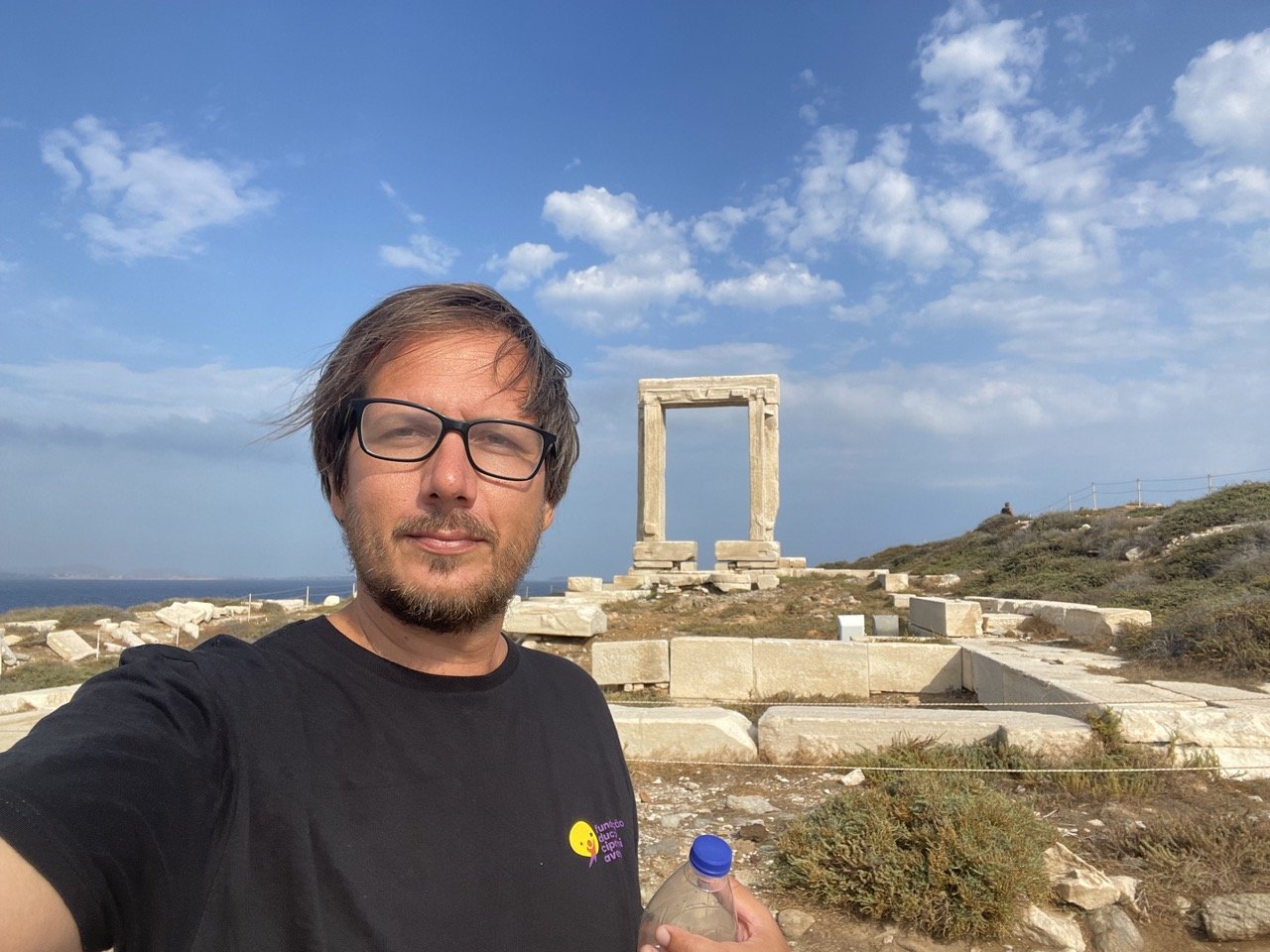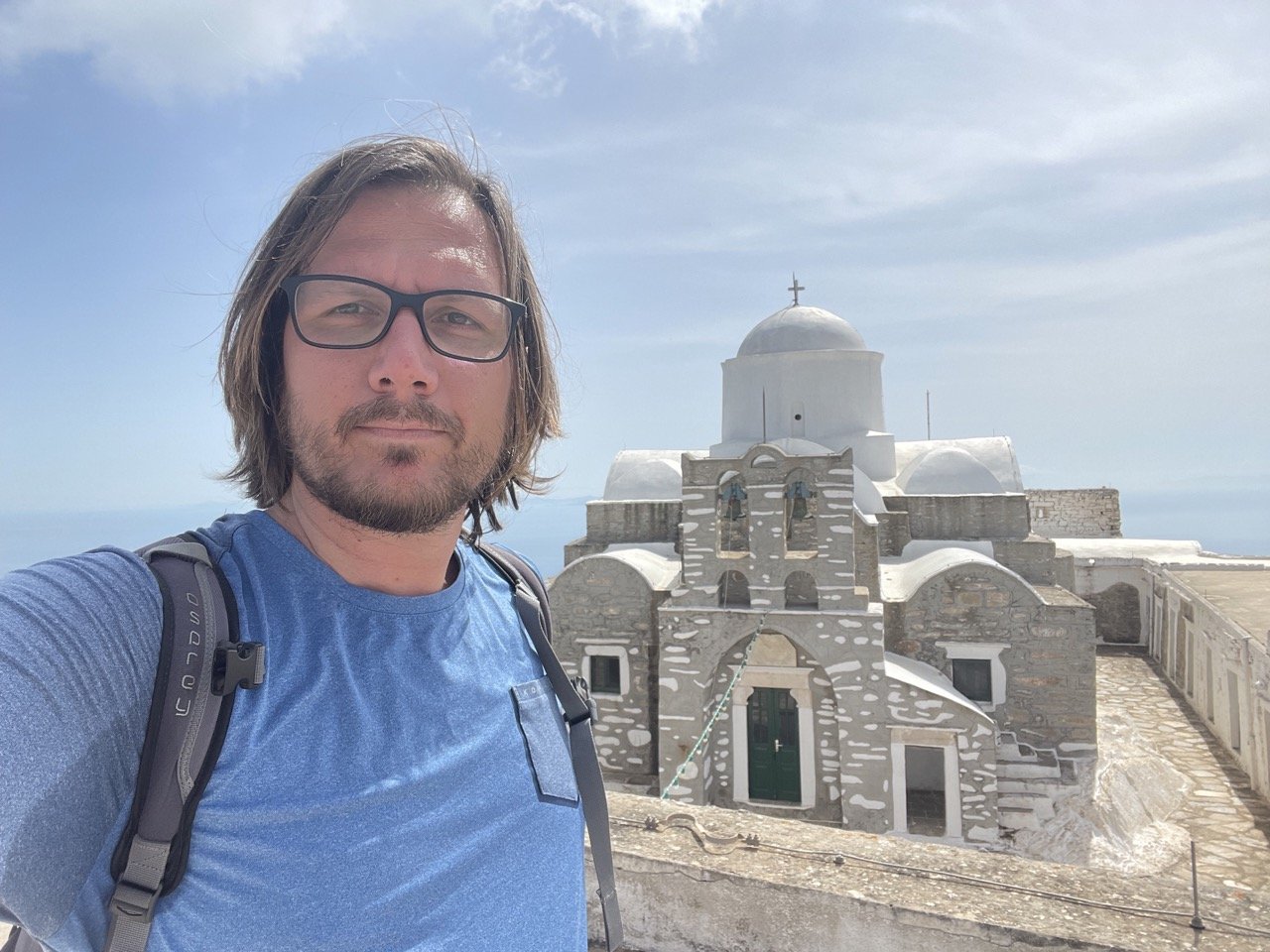A Local’s Guide to Visiting Syros, Greece
Affiliate disclosure: some of the links in this article are affiliate links. If you book using one of them, we’ll earn a small commission. All of our info is free to read and free of ads, so we appreciate it!
Syros, the capital of the Cyclades, marches to a different drummer. It has the Greek island beaches that everyone loves, but rather than typical sugar cube Cycladic villages, it boasts one of Greece’s best-preserved 19th-century cities; lively, colorful Ermoupolis.
Once the main port and commercial powerhouse of Greece, Ermoupolis is a wealthy, cultural and sophisticated Neoclassical gem, home to a branch of the University of the Aegean. On Syros tourism is not the be-all end-all, and it’s easy not to feel like just another tourist.
The north half of the island, known as the Apano Meria, is wild, barren and mountainous, with a west coast scalloped with beautiful wild beaches accessible only by foot or boat. The far greener southern half of the island is dotted with small seaside resorts and beaches, several of which fly the Blue Flag.
Table of Contents


Where is Syros
How to get here
Arriving by plane
Syros has a small domestic airport, with daily flights from Athens that take 25 minutes; tickets start at $156.
Arriving by ferry
There are three or four daily ferries from Piraeus, the port of Athens; these take 4 hours on a conventional ferry (from $22) and 2 hours on a high-speed ferry (from $72). Occasionally ferries depart from the port of Rafina, on Attica’s east coast (which has direct bus connections from Athens Airport).
Where to book ferry tickets
To check schedules and prices, I recommend using FerryScanner which is an aggregator that shows options from a bunch of different ferry companies. Their schedules are always up to date, it’s easy to use, and the price difference between using them and booking direct is negligible.
Main connecting ports
From Mykonos: There are 50-70 minute ferry links year-round, more frequently in the summer. Expect to pay around $18; a 25 minute voyage by Sea Jet is around $43.
From Santorini Daily departures operate between early April and late September, take 2 hours and 40 minutes, and cost around $69 each way.
From Naxos Several links a week operate year round; a 3 hour trip by ferry costs around $22. There are also daily links in summer on Sea Jets which take 70 minutes and start at $64.
Why visit
Syros has 20 excellent beaches scattered around its southern and western shores, but the most compelling reason to visit the island is its beautiful Neoclassical city Ermoupolis, the capital of the Cyclades and one of the cultural capitals of Greece.
The city is home to excellent restaurants, chic boutique hotels in historic mansions, and ample opportunity to hear live music, especially rebetiko, the Greek urban blues, the legacy of one of its greatest rebetiko composers, Markos Vamvakaris (1905-72), a native of Syros.
Visiting Syros is like combining a beach holiday with a city break—nothing is very far and buses in summer from Ermoupolis to the beaches are frequent. This is an island the appeals to families and cultural visitors, with its elegant hotels in Neoclassical mansions, excellent restaurants, and the chance to go to the theatre or a concert. It’s not an island with big all-inclusive resorts and wild parties.


What is Syros known for
Syros is almost synonymous with its capital city, Ermoupolis, a striking vision if you approach by sea, with its buildings rising from the port up a pair of steep hills. Shipyards and other industries occupy the south end of the harbour, while to the north, elegant 19th-century townhouses gaze over the sea, with steps down to the water.
In between, the bustling commercial, administrative and cultural core of Ermoupolis extends around the main square, Plateia Miaoulis, bustling day and night year-round, full of shops, bars and restaurants. From the square, steps (and a few steep streets) lead up into the mostly residential hills, offering spectacular views and traditional tavernas.
Outside of the city, southern Syros is hilly and fringed with beaches and small seaside resorts. This area also supports most of the island’s agriculture (olives, pistachios, grapes, and vegetables, as well as dairy farms that produce some fine cheeses). Unlike most Cycladic islands, some of the villages (notably the seaside resort village of Poseidonia) are dotted with summer villas belonging to actual locals - built by the merchants and sea captains of Ermoupolis.
The wild northern half of the island, the Apano Meria, is for explorers. Mountainous and mostly barren and rocky, but dotted with coves and wild beaches, Apano Meria surprisingly was the population center in ancient times. It has the island’s few archaeological sites, as well as a few vineyards and shepherds. A road goes as far as Ai Michalis and Kampos, the northernmost hamlets, where you can pick up trails to the beaches.
Syros is also known for rebetiko music, the Greek Blues, born in the years of massive unemployment following the Greece-Turkey Population Exchange in 1923. One of the best places to hear rebetiko is up in Apano Syros, the one corner of Syros that looks a Cycladic island, with its houses crowded along hundreds of steps (fortunately city buses will take you to the top and you can walk down rather than up).
One very interesting aspect of Syros is the almost even split between Catholic and Greek Orthodox residents. The capital, where most of the population lives, is built on a pair of steep hills; Ano Syros and Vrondado. Ano Syros has been Catholic ever since it was settled by the Venetians in the early 13th century, while Vrondado is Greek Orthodox. Today some 11,000 islanders are Orthodox, and 9,000 Catholic.
Ermoupolis was born in the early 19th century when French protection (because of all those Catholics) allowed it to stay neutral during the Greek War of Independence. Refugees—including many ship owners and merchants--flocked here when their own islands were devasted by the Ottoman army.
They created modern Greece’s most important port, as well as the an industrial, commercial and shipbuilding center. It was so wealthy that the city’s main square, Plateia Miaoulis, is paved with gleaming marble. The prosperous merchants and shipowners also built Modern Greece’s first theater, introducing the country to opera.
How many days to spend
Three days on Syros is probably enough for most visitors: a day to explore Ermoupolis, another to spend time on a beach, and a third to take a cruise or hike in the north.
But because Syros is so friendly and so Greek, it’s a great island for feeling like a local, so you might want to stay longer just to join in the fun, especially during one of the festivals.
Where to stay
The choice here is city or beach: the city (Ermoupolis) is by far the liveliest (and potentially noisiest) place to stay, with a great choice of restaurants and music bars. The city’s boutique hotels in the town houses are destinations in themselves, if on the pricey side.
Ermoupolis
Among the Neoclassical mansions converted into hotels there’s the art-filled Aristide House ($350+ per night) where the interiors and suites have an Art Deco flair and come with plunge pools
Waterfront Boutique Hotel Ploes, ($350+) where you can dive off the terrace into the sea, is also exceedingly nice.
Villa Maria, has fine views over Ermoupolis and the sea, and offers guests the option of taking 1 to 8 day Greek cooking lessons ($80).
For something comfortable but very moderately priced, try Ostria ($60), a guesthouse with rooms and apartments near the port.
Kini
If you want to stay by a beach, Kini on the west coast is only 8km from Ermoupolis and offers a fun atmosphere and a good range of accommodation of all kinds, from villas to apartments, along with bars and tavernas; it’s also the best base for cruises to the deserted beaches in the north.
The new Blue Harmony Hotel ($150, minimum 3 night stay) is a little family-run hotel with a great staff in one of the best locations on the beach, offering family rooms as well as doubles; open May-September.
Galassas
Larger Galassas to the south of Kini is the most popular beach resort on the island, and about the same distance from Ermoupolis; it family-oriented accommodation and tavernas. Both villages enjoy beautiful sunsets.
The recently renovated white and bright suites and rooms at the Hotel Benois ($150) come with a pool and a good restaurant. Or go eco-glamping in a bungalow, retro wooden hut or tent at Anassa Cycladic Village ($75), which offers experiences and courses ranging from yoga and Cycladic culture, to pistachio harvesting in late August and olive harvesting in October and November.
Finikas
On the southwest coast of Syros, 10 km from Ermoupolis, Finikas is a quieter choice. It has a long sandy beach and good seafood tavernas, much patronized by the locals. It merges into neighbouring Poseidonia, the island’s elite resort with its fashionable summer villas.
Brazzera Hotel is a charming small hotel with a great staff just steps away from the beach, with family rooms as well as doubles ($150).


What to see & do
1. Take a boat to deserted beaches
Syros Adventure based in Kini offers excursions to the unspoiled beaches along the island’s northwest coast that are difficult to reach by land—Varvarousa, Aetos, Lia, Megas Lakkos, Marmari, and Grammata. The latter is in a bay sheltered from the winds, where sailors from Hellenistic to Byzantine times left inscriptions in the rock, offering prayers and thanks.
2. Find the El Greco
Located in the Church of the Dormition in Ermoupolis, the signed painting of the Dormition of the Virgin by Domenikos Theotokopoulos (aka El Greco) was painted by the Renaissance master before he left Greece for Venice and Spain.
3. Go wine tasting
There are several winegrowers on Syros, including the Chatzakis Winery way up north in Ai Michalis, which you can visit by booking ahead. Or taste several different island wines in style with Syros Wine Trails.
4. Have a coffee in the Town Hall
This palatial building dominating Plateia Miaoulis was designed by Greece’s most important 19th-century architect, Ernst Ziller and has a pretty café inside—with something unexpected: the carriage of Empress Elizabeth ‘Sissi’ of Austria, purchased at an auction by a local businessman.
5. Trek to the chapel of Agios Stefanos
This spectacular chapel embedded in cliff over the sea was founded by a sailor to thank St Stephen for rescuing him from a giant octopus. The track begins south of Galissas and takes an hour and a half although you can also drive much closer and walk ten minutes along the track; in both cases wear sturdy shoes.
6. Listen to the music
There are frequent performances at Ermoupolis’s Apollon Theater, Greece’s oldest indoor theatre, an Italianate gem of 1864 and now beautifully restored. You can hear rebetiko recordings by Márkos Vamvakáris at the small museum in his honour in Ano Syros—or hear it live in a bar or taverna; just ask around
7. Check out the sea creatures
Near the beach in Kini, this aquarium is the only one in the Cyclades, and not to be missed especially if you have children in tow. It’s linked to a little museum of fishing boats.
8. Take home some treats
In Ermoupolis seek out the shop of Yiannis Aggelikas, who makes the island’s famous loukoumi (aka Turkish delight) in rose petal, mastic, bergamot, rose-sugar, clementine, almond, pistachio, walnut and other flavours. He also makes delicious halvadopita, a nougat sandwich made with honey, sugar, vanilla, egg whites and almonds.
9. Visit the Industrial Museum and a Textile Factory
Not what most people expect to find on a Greek island, but fascinating. The museum on the south edge of Ermoupolis is full of surprises, including a precocious Enfield 8000, an electric car manufactured here in the early 1970s.
Near the museum, one of the city’s old textile works has been beautifully restored down to the smallest detail by Hermoupolis Heritage. You can take a tour, and even eat a typical workers’ lunch.
Best beaches
Galissas
A sandy Blue Flag beach, great for families, with water sports (including windsurfing) sunbeds, umbrellas, tamarisks and tavernas. Be sure to take the path up to the Catholic chapel of Agios Pakou for the sunsets
Kini
A sandy beach with a sandy bottom on the island’s west coast, Kini is well equipped with hotels and taverna; its landmark is an unusual statue of a mermaid with a drowned sailor on her lap. If it’s too busy, try nearby the nearby pebble Delfini beach or the shady little sands of Lotos.
Azolimnos
Lined with tamarisks, sandy Azolimnos is only 5km away from Ermoupolis and can be reached by bus. It has free umbrellas and sun beds on a first come, first serve basis.
Agathopes
Close to Posidonia, Agathopes is an immaculate sandy beach, with shallow, transparent waters, overlooking a small islet; a good bet for families.
Amerikanou
One of the wild beaches on Syros’s northwest coast, accessible only by boat or a long walk from Kampos, this beach with pure transparent waters is named after the American who fell in love with it, bought it, and spent years planting a small forest of pines and tamarisks—making it one of the few in the north with natural shade.


How to get around
Syros covers 32 square miles, and 99 per cent of the population live in Ermoupolis or in the dozen villages in the south, none of which is more than a half hour away. Buses from the station near the port in Ermoupolis provide two or three daily connections between the towns of the island in winter, and more in the summer. Tickets cost $2.
Unless you are keen on exploring the north, you can easily get between the city and beaches with buses and taxis. If you do want a car, even for just a day, most car rental places on the island are located both at the airport and near the port in Ermoupolis.
For car rentals, try Syros4Seasons, Gaviotis Travel or Maistrali; the latter also rent out bicycles and motorbikes. It’s best to book ahead because there are limited numbers of vehicles on the island.
If you’re planning on renting a car, I also always recommend checking prices on DiscoverCars. It’s a car rental website that includes offerings from all the major international rental companies as well as lots of smaller local agencies, which often have much better pricing. You can find often great deals.
Weather & when to visit
Winter
If chance brings you to the Cyclades in winter, Syros is the island to aim for; many of the others tend to close down, but Ermoupolis is open and lively all year. In late February it hosts rollicking celebrations for Apokries (Greek Carnival). And there’s always live music on weekends.
Spring
In spring, temperatures are perfect for long walks, and the beaches are warm enough for lazy basking even if some may find the sea a bit chilly. Greek Orthodox Easter is the biggest holiday in the country, but on Syros the festivities are unique because the island’s Catholic and Orthodox celebrate together (on Orthodox Easter) with processions and fireworks in Ermoupolis.
Summer
This is hottest and busiest time on Syros, when everyone hits the beaches. For over two weeks in July it hosts the International Festival of the Aegean, featuring classical music and opera in the Apollon Theatre. It’s also a great time to hear rebetika, as musicians gather in August in Ano Syros in honour of Markos Vamvakaris, culminating in the late August-early September Rebetiko Festival.
Fall
Fewer tourists and cooler temperatures make this a great time to visit. The sea is still warm enough for swimming into late October, and the presence of students gives Ermoupolis a youthful buzz.


More Greece travel info
For more advice on planning your trip to Greece, have a look at some of our other guides and itineraries!

Connect with Luca














